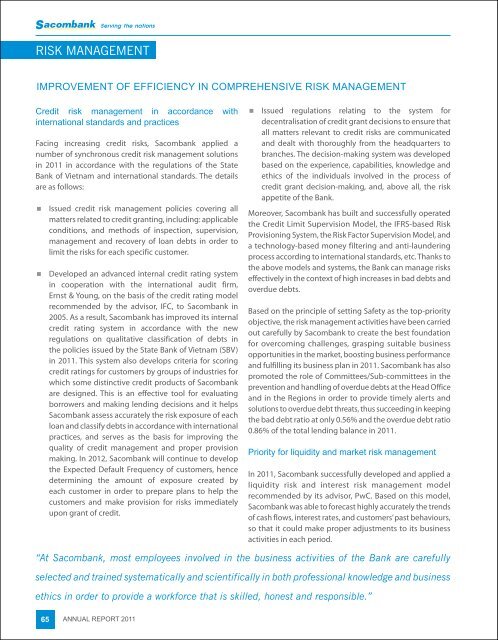notes to the consolidated financial statements - Sacombank
notes to the consolidated financial statements - Sacombank
notes to the consolidated financial statements - Sacombank
You also want an ePaper? Increase the reach of your titles
YUMPU automatically turns print PDFs into web optimized ePapers that Google loves.
RISK MAnAGEMEnt<br />
IMPROVEMENT OF EFFICIENCY IN COMPREHENSIVE RISK MANAGEMENT<br />
Credit risk management in accordance with<br />
international standards and practices<br />
Facing increasing credit risks, <strong>Sacombank</strong> applied a<br />
number of synchronous credit risk management solutions<br />
in 2011 in accordance with <strong>the</strong> regulations of <strong>the</strong> State<br />
Bank of Vietnam and international standards. The details<br />
are as follows:<br />
n Issued credit risk management policies covering all<br />
matters related <strong>to</strong> credit granting, including: applicable<br />
conditions, and methods of inspection, supervision,<br />
management and recovery of loan debts in order <strong>to</strong><br />
limit <strong>the</strong> risks for each specific cus<strong>to</strong>mer.<br />
n Developed an advanced internal credit rating system<br />
in cooperation with <strong>the</strong> international audit firm,<br />
Ernst & Young, on <strong>the</strong> basis of <strong>the</strong> credit rating model<br />
recommended by <strong>the</strong> advisor, IFC, <strong>to</strong> <strong>Sacombank</strong> in<br />
2005. As a result, <strong>Sacombank</strong> has improved its internal<br />
credit rating system in accordance with <strong>the</strong> new<br />
regulations on qualitative classification of debts in<br />
<strong>the</strong> policies issued by <strong>the</strong> State Bank of Vietnam (SBV)<br />
in 2011. This system also develops criteria for scoring<br />
credit ratings for cus<strong>to</strong>mers by groups of industries for<br />
which some distinctive credit products of <strong>Sacombank</strong><br />
are designed. This is an effective <strong>to</strong>ol for evaluating<br />
borrowers and making lending decisions and it helps<br />
<strong>Sacombank</strong> assess accurately <strong>the</strong> risk exposure of each<br />
loan and classify debts in accordance with international<br />
practices, and serves as <strong>the</strong> basis for improving <strong>the</strong><br />
quality of credit management and proper provision<br />
making. In 2012, <strong>Sacombank</strong> will continue <strong>to</strong> develop<br />
<strong>the</strong> Expected Default Frequency of cus<strong>to</strong>mers, hence<br />
determining <strong>the</strong> amount of exposure created by<br />
each cus<strong>to</strong>mer in order <strong>to</strong> prepare plans <strong>to</strong> help <strong>the</strong><br />
cus<strong>to</strong>mers and make provision for risks immediately<br />
upon grant of credit.<br />
65<br />
ANNUAL REPORT 2011<br />
n Issued regulations relating <strong>to</strong> <strong>the</strong> system for<br />
decentralisation of credit grant decisions <strong>to</strong> ensure that<br />
all matters relevant <strong>to</strong> credit risks are communicated<br />
and dealt with thoroughly from <strong>the</strong> headquarters <strong>to</strong><br />
branches. The decision-making system was developed<br />
based on <strong>the</strong> experience, capabilities, knowledge and<br />
ethics of <strong>the</strong> individuals involved in <strong>the</strong> process of<br />
credit grant decision-making, and, above all, <strong>the</strong> risk<br />
appetite of <strong>the</strong> Bank.<br />
Moreover, <strong>Sacombank</strong> has built and successfully operated<br />
<strong>the</strong> Credit Limit Supervision Model, <strong>the</strong> IFRS-based Risk<br />
Provisioning System, <strong>the</strong> Risk Fac<strong>to</strong>r Supervision Model, and<br />
a technology-based money filtering and anti-laundering<br />
process according <strong>to</strong> international standards, etc. Thanks <strong>to</strong><br />
<strong>the</strong> above models and systems, <strong>the</strong> Bank can manage risks<br />
effectively in <strong>the</strong> context of high increases in bad debts and<br />
overdue debts.<br />
Based on <strong>the</strong> principle of setting Safety as <strong>the</strong> <strong>to</strong>p-priority<br />
objective, <strong>the</strong> risk management activities have been carried<br />
out carefully by <strong>Sacombank</strong> <strong>to</strong> create <strong>the</strong> best foundation<br />
for overcoming challenges, grasping suitable business<br />
opportunities in <strong>the</strong> market, boosting business performance<br />
and fulfilling its business plan in 2011. <strong>Sacombank</strong> has also<br />
promoted <strong>the</strong> role of Committees/Sub-committees in <strong>the</strong><br />
prevention and handling of overdue debts at <strong>the</strong> Head Office<br />
and in <strong>the</strong> Regions in order <strong>to</strong> provide timely alerts and<br />
solutions <strong>to</strong> overdue debt threats, thus succeeding in keeping<br />
<strong>the</strong> bad debt ratio at only 0.56% and <strong>the</strong> overdue debt ratio<br />
0.86% of <strong>the</strong> <strong>to</strong>tal lending balance in 2011.<br />
Priority for liquidity and market risk management<br />
In 2011, <strong>Sacombank</strong> successfully developed and applied a<br />
liquidity risk and interest risk management model<br />
recommended by its advisor, PwC. Based on this model,<br />
<strong>Sacombank</strong> was able <strong>to</strong> forecast highly accurately <strong>the</strong> trends<br />
of cash flows, interest rates, and cus<strong>to</strong>mers’ past behaviours,<br />
so that it could make proper adjustments <strong>to</strong> its business<br />
activities in each period.<br />
“At <strong>Sacombank</strong>, most employees involved in <strong>the</strong> business activities of <strong>the</strong> Bank are carefully<br />
selected and trained systematically and scientifically in both professional knowledge and business<br />
ethics in order <strong>to</strong> provide a workforce that is skilled, honest and responsible.”




